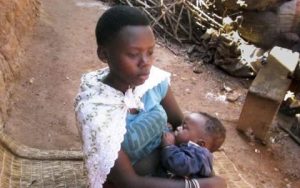Catherine Nansereko stands by the dusty roadside of Katoogo trading centre in Nama sub-county, Mukono district.

Dressed in loose-fitting clothes with her half-naked three-month-old baby, the 17-year-old can but only see a dark future. As the cloud-covered sky promises torrents of rain, Nansereko and her baby’s attire seem unfit for the probable weather. As I approach her, she scratches through her unkempt dreadlocks and moves a step back.
Perhaps, my heart tells me, I appear undeserving of her story. After introducing myself as a journalist, she accepts to speak to me on condition that I do not take her photograph. Nansereko escaped from home after her jobless mother could no longer raise her S2 school fees.
“When my mother failed to pay my fees, I escaped from home and started working as a house girl,” she says. “It was through this situation that the father of my baby found me, convinced me and now I have his baby.”
Although not sure whether her baby-daddy, John Paul Buule, will continue looking after her, Nansereko is glad he has not neglected her in spite of her age and an unpredictable future. Buule, she says, works in a forest.
JOURNEY TO TEENAGE MOTHERHOOD
Born to Fred (RIP) and Safiina Ssennoga of Najjembe in Jinja, this fifth-born of their 10 children did not realise she was pregnant until the foetus was four months old.

“I was advised by a certain lady to go for antenatal care but as you know these local health centres, there were no drugs. Buule looked for some money and bought for me the drugs as prescribed by the nurses,” Nansereko narrates.
When delivery time came, she was referred to Kawolo hospital because her situation, she was told, was too complicated to be handled at Katoogo health centre III.
Because of the inadequate drugs, Nansereko appeals to the government to provide all the necessary equipment to at least all health centre IIIs so that health services can be easily accessed.
Nansereko contributes to the unkind 49 percent of girls married before the age 18, according to the Uganda Demographic and Health Survey (2011). At least, despite the complications she had during childbirth, the nurses at Kawolo hospital ensured she does not become one of the 438 mothers that die per 100,000 births.

